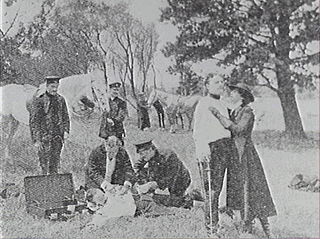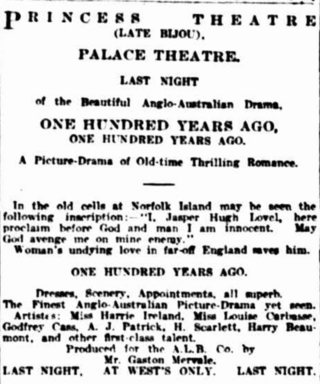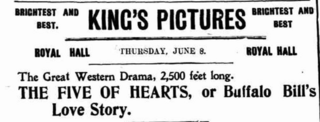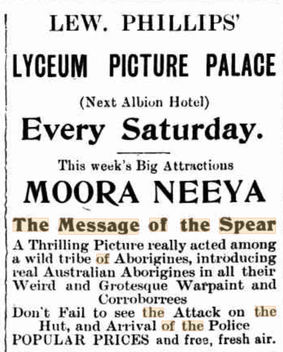Related Research Articles

King Solomon's Mines is a 1937 British adventure film directed by Robert Stevenson and starring Paul Robeson, Cedric Hardwicke, Anna Lee, John Loder and Roland Young. A film adaptation of the 1885 novel of the same name by Henry Rider Haggard, the film was produced by the Gaumont British Picture Corporation at Lime Grove Studios in Shepherd's Bush. Sets were designed by art director Alfred Junge. Of all the novel's adaptations, this film is considered to be the most faithful to the book.

The Midnight Wedding is a 1912 Australian silent film directed by Raymond Longford based on a popular Ruritanian stage play in which Longford had appeared. It is considered a lost film.
The Woman Suffers is a 1918 Australian silent film directed by Raymond Longford. It is a melodrama starring Lottie Lyell. Two-thirds of the movie still survives.

The Enemy Within is a 1918 Australian silent film starring renowned Australian sportsman Snowy Baker in his first screen role.

Captain Midnight, the Bush King is a 1911 Australian silent Western film about the fictitious bushranger Captain Midnight. It was the directorial debut of actor Alfred Rolfe. The film is based on the play of same name by W. J. Lincoln and Alfred Dampier. Captain Midnight, the Bush King is now considered lost.
The Life of Rufus Dawes is a 1911 Australian silent film based on Alfred Dampier's stage adaptation of the 1874 novel For the Term of His Natural Life produced by Charles Cozens Spencer.

The Lady Outlaw is a 1911 Australian silent film set in Van Diemen's Land during convict days.
The Love Tyrant is a 1912 Australian silent film directed by Alfred Rolfe. It was described as an "Australian drama about the back blocks" and a "stirring drama full of thrilling incidents". It was set during the early bushranging days.
Won on the Post is a 1912 Australian silent film directed by Alfred Rolfe set against a backdrop of horseracing.
Moira, or The Mystery of the Bush is a 1912 Australian silent film directed by Alfred Rolfe.
Australia's Peril is a 1917 Australian silent film directed by Franklyn Barrett. It is considered a lost film.
Know Thy Child is a 1921 Australian silent film directed by Franklyn Barrett.

One Hundred Years Ago is a 1911 Australian silent film directed by Gaston Mervale. It features an early screen performance from Louise Lovely and is considered a lost film.
The Colleen Bawn is a 1911 Australian silent film directed by Gaston Mervale starring Louise Lovely. It is adapted from a popular melodrama by Dion Boucicault.

The Five of Hearts, or Buffalo Bill's Love Story is a 1911 Australian film from Edward Irham Cole based on a stage play about Buffalo Bill which Cole had performed extensively. It is also known as A Maiden's Distress or Buffalo Bill. It was reportedly the longest of Cole's films.
Gambler's Gold is a 1911 Australian film based on the 1911 novel by Arthur Wright. It is considered a lost film.

Dan Morgan is a 1911 Australian film from Charles Cozens Spencer about the bushranger Daniel Morgan. It was said to be starring "Alfred Rolfe and company". Rolfe directed three movies for Spencer, all starring himself and his wife Lily Dampier so there is a chance he may have directed this one and that it starred his wife. A prospectus for the Australian Photo Play Company said he directed it. It is considered a lost film.
The Australian Film Syndicate was a short lived Australian film production company based in North Sydney. According to novelist Arthur Wright, "A local draper put a lot of money into it, and lost it; though all the films produced were not 'duds.' One which paid its way well was an adaptation of my novel, Gamblers Gold."
Only a Factory Girl is a 1911 Australian film. Very little is known about it and it is considered a lost film.

Moora Neeya, or the Message of the Spear is a 1911 Australian silent film which was the first Australian movie to emphasise aboriginal people or "the first full Australian aboriginal drama yet produced."
References
- ↑ "Advertising". Referee. No. 1314. New South Wales, Australia. 10 January 1912. p. 16. Retrieved 26 February 2024– via National Library of Australia.
- ↑ "Advertising". The Sydney Morning Herald . No. 23, 139. New South Wales, Australia. 11 March 1912. p. 2. Retrieved 26 February 2024– via National Library of Australia.
- 1 2 Andrew Pike and Ross Cooper, Australian Film 1900–1977: A Guide to Feature Film Production, Melbourne: Oxford University Press, 1998, p33
- ↑ "Theatrical Gazette". Referee . No. 1315. New South Wales, Australia. 17 January 1912. p. 15. Retrieved 26 February 2024– via National Library of Australia.
- ↑ "Advertising". The Sydney Morning Herald . 1 April 1912. p. 2. Retrieved 23 March 2012– via National Library of Australia.